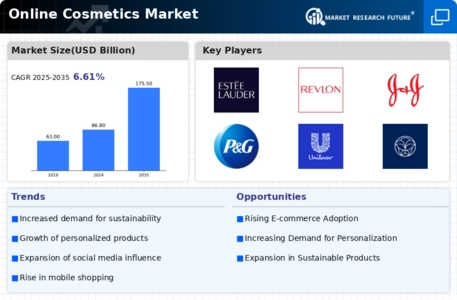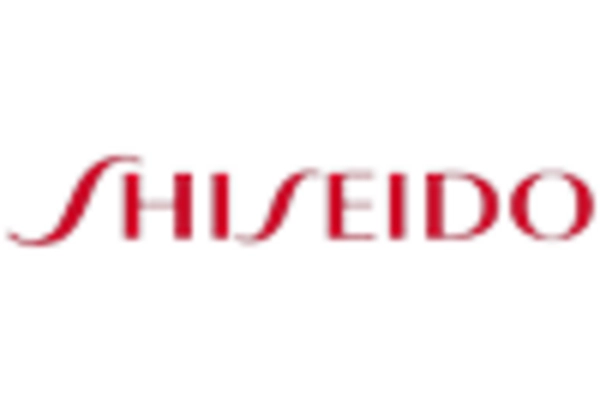The Online Cosmetics Market is currently characterized by a dynamic competitive landscape, driven by rapid digital transformation and evolving consumer preferences. Major players such as L'Oreal (FR), Estée Lauder (US), and Procter & Gamble (US) are at the forefront, each adopting distinct strategies to enhance their market positioning. L'Oreal (FR) emphasizes innovation through its investment in augmented reality (AR) technologies, allowing consumers to virtually try products before purchase, thereby enhancing the online shopping experience. Meanwhile, Estée Lauder (US) focuses on expanding its digital footprint through strategic partnerships with e-commerce platforms, which facilitates broader market access and consumer engagement. Procter & Gamble (US) is leveraging data analytics to optimize its supply chain and personalize marketing efforts, indicating a trend towards data-driven decision-making in the sector.
The business tactics employed by these companies reflect a concerted effort to localize manufacturing and optimize supply chains, which are crucial in a moderately fragmented market. This competitive structure allows for a diverse range of offerings, yet the influence of key players remains substantial. The collective strategies of these companies not only enhance their operational efficiencies but also contribute to a more resilient market environment, capable of adapting to consumer demands and global challenges.
In August 2025, L'Oreal (FR) launched a new line of eco-friendly cosmetics, aligning with the growing consumer demand for sustainable products. This strategic move not only reinforces L'Oreal's commitment to sustainability but also positions the brand favorably among environmentally conscious consumers. The introduction of this product line is likely to enhance brand loyalty and attract a new demographic, thereby expanding its market share.
In September 2025, Estée Lauder (US) announced a collaboration with a leading social media platform to create an interactive shopping experience that integrates influencer marketing with direct purchasing options. This initiative is significant as it capitalizes on the increasing trend of social commerce, potentially driving higher conversion rates and enhancing customer engagement. By merging content with commerce, Estée Lauder is likely to strengthen its brand presence in the digital space.
In July 2025, Procter & Gamble (US) unveiled a new AI-driven platform designed to personalize consumer experiences across its online channels. This platform utilizes machine learning algorithms to analyze consumer behavior and preferences, allowing for tailored product recommendations. The strategic importance of this initiative lies in its potential to enhance customer satisfaction and retention, as personalized experiences are increasingly becoming a key differentiator in the online cosmetics market.
As of October 2025, the competitive trends in the Online Cosmetics Market are heavily influenced by digitalization, sustainability, and the integration of artificial intelligence. Strategic alliances, such as those seen between Estée Lauder (US) and social media platforms, are reshaping the landscape, fostering innovation and enhancing consumer engagement. Looking ahead, competitive differentiation is expected to evolve, with a pronounced shift from price-based competition towards innovation, technological advancements, and supply chain reliability, as companies strive to meet the sophisticated demands of modern consumers.


















Leave a Comment